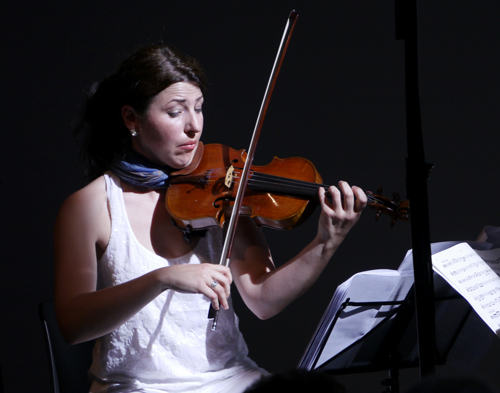by Daniel Hathaway

Johann Sebastian Bach has to be one of the most frequently arranged composers of all time, and we have yet to meet a rescoring of his music that didn’t work at least on some level. But taking a piece originally scored for two-manual harpsichord and reworking it for violin, viola and cello would seem to be a real stretch.
In keeping with ChamberFest’s obsession with the number three during its third season, there were that many reasons why this arrangement worked on Saturday. First, Bach’s music is so pure and abstract that its instrumentation really doesn’t matter. Second, as string players who provide music for weddings and cocktail receptions know full well, a string trio is versatile enough to at least suggest the substance of any piece of music. Third, the arranger in this case is the Russian-born, Juilliard-trained violinist Dmitry Sitkovetsky, who really knows what he’s doing.
Okay, four reasons. Last but not least, violinist Amy Schwartz Moretti, violist Dmitri Murrath and cellist Gabriel Cabezas are splendid musicians who have the concentration and stamina to play thousands of notes over the course of an hour and eleven minutes with precision and accuracy as well as unflagging musicality.
That musicality was obvious both in the tender little Sarabande from Anna Magdalena Bach’s Notebook that inspired Johann Sebastian Bach’s thirty variations, and in the slower and more expressive movements, which are often in the minor mode (the long, fifteenth variation was particularly ravishing). But the vigorous, virtuosic movements were no less sensitively played.
Sitkovetsky’s clever redistributions of musical lines sometimes reduced Bach’s textures dramatically. Variation 8 paired instruments in different combinations. The French overture at dead center of the piece began with violin and cello, adding the viola for the fugue. Saving special effects for later in the piece when ears might have begun to tire, in Variation 19 Sitkovetsky suddenly introduced pizzicati in violin and cello, giving a usually hidden inner line to the bowed viola. The runs in Variation 26 were breathtaking.
Bach’s alternating triads in Variation 29 translated well to slurred chords in the strings, but in Variation 28 Sitovetsky didn’t even try to replicate the effect of opposable thumbs and second fingers playing inner lines on the keyboard. Instead, he reduced Bach’s musical content to something quite different in texture but more idiomatic for string trio.
After all that serious counterpoint, the trio perfectly caught Bach’s folksy sense of humor in the final variation, a mashup of two songs (“It’s been so long since I’ve seen you,” and “Cabbage and turnips have driven me away”), referring to the hour or so since the original Sarabande had been heard. That little aria’s return was as placid and lovely at the end as at the beginning.
No matter what the musical content, Johann Sebastian Bach’s works are always supported by a rigorous structure that is mathematical or highly symmetrical in design. Every third variation in the “Goldbergs” features a canon, first at the unison, then at every rising interval through Variation 27, a canon at the ninth. Iannis Xenakis composed with a similar approach to infrastructure, reflecting his training as an engineer and an architect.
That’s undoubtedly how Xenakis’s Kottos for Solo Cello wound up at the beginning of Saturday’s program, though its mathematical underpinnings are more harmonious as numbers than as music. Among the most ancient characters in Greek mythology, Kottos was one of the fifty-headed giants who controlled violent events of nature, and is depicted, in the composer’s words, with sounds that are “rough, harsh and full of noise.”
Cellist Julie Albers held the attention of the capacity audience for all ten minutes of Xenakis’s score, from its violent, opening scrapings through its momentary episodes of lyricism to its gripping slides and final, fading high note. Turbulent, but colorful and strongly rhythmic, the piece shows clear influences of Messiaen, Xenakis’s mentor.
Albers, who had already lost bow hairs in the opening moments of Kottos, played with strength and amazing control, especially in the long, full-range slides that dominated the piece. Her arresting performance supported ChamberFest’s brilliant decision about what to program with the “Goldberg” Variations.
Photos by Gary Adams.
Published on ClevelandClassical.com June 24, 2014.
Click here for a printable copy of this article.





